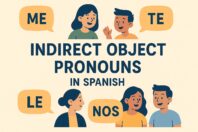Informal Commands in Spanish: How and when to use tú commands

Get our free email course, Shortcut to Conversational.
Have conversations faster, understand people when they speak fast, and other tested tips to learn faster.
More infoAs you probably know by now, you often need to choose between using formal vs informal language in Spanish, depending on who you’re speaking with. This applies whether you’re addressing someone directly, asking them a question, or giving informal commands in Spanish.
Your first introduction to this concept was probably early on in your Spanish lessons when you studied the differences between usted vs tú. Today we’re going to revisit this concept, specifically with respect to giving informal Spanish commands in the tú form.
We’ll look at how to conjugate tú commands in Spanish in both the affirmative and the negative, we’ll touch on sentence structure for both, and then we’ll review the contexts where it’s suitable to give these informal commands in Spanish. We’ll finish up with some exercises so you can practice what you’ve learned.
What is an informal command in Spanish?
A command in Spanish is used to directly address another person, and give them an order or instruction. The command form uses the imperative mood, so we can also refer to it as the imperative form in Spanish.
In today’s post on informal commands, we’re looking at orders being given to a single person using informal language. In other words, we’re considering conjugations in the second-person singular: the tú form of you in Spanish. For this reason, these are often referred to as informal tú commands.
What is the difference between formal and informal commands?
In Spanish, informal commands are used among friends, coworkers, relatives, or when addressing a child, whereas formal commands are often used for elders, employees, authority figures, and people you don’t know.
If in doubt, you can always err on the side of caution and choose the formal approach. As you engage with Spanish speakers over time, you’ll understand these little nuances better.
In this article, you will find the most common informal commands in Spanish, but if you need a more comprehensive guide to formal vs informal commands in Spanish, you can always check out our in-depth post on the Spanish imperative mood. We also have several specific posts for using the imperative mood, including nosotros commands, useful commands for teachers and babysitters, and Spanish dog commands.
How do you make an informal command in Spanish?
When making informal commands, Spanish has two different forms depending on whether we’re making them in affirmative or negative. We’ll start with affirmative commands. Spanish negative commands will follow.
Since we’re giving orders here, Spanish exclamation points are very common around the conjugated verb: Remember this! – ¡Recuerda esto!
Imperative conjugation: Affirmative informal commands
When we think of Spanish imperative conjugation, we’re usually considering the affirmative form. In this section we’ll take a look at the conjugations specifically for these informal tú commands.
For almost all Spanish verbs (we’ll see the 8 exceptions in a moment), the affirmative tú imperative conjugation is identical to the present tense third-person singular conjugation.
This is good news for Spanish learners, because once you’ve learned a verb’s present tense conjugation you automatically know its affirmative imperative tú conjugation! This means that even for irregular verbs, you just use the exact same conjugation that you would use in present tense for él, ella, and usted.
Let’s review these regular endings for regular Spanish verbs. We’ll use estudiar (to study), leer (to read), and vivir (to live) to demonstrate the regular -ar, -er, and -ir conjugations.
| Verb groups | Ending | Regular infinitive | Conjugation |
| -ar verbs | -a | estudiar | estudia |
| -er verbs | -e | leer | lee |
| -ir verbs | -e | vivir | vive |
- Study for your final test! – ¡Estudia para tu prueba final!
- Read carefully, that book is a little bit confusing – Lee minuciosamente, ese libro es un poquito confuso.
- You live wherever you want, it is your life! – ¡Vive adonde quieras, es tu vida!
Remember that even most irregular Spanish verbs follow this same rule, so as long as you know the irregular present él/ella/usted conjugation, you know the affirmative imperative tú conjugation. Here are some of the conjugations for important irregular verbs.
| Irregular verb infinitive | English | Él/Ella/Usted present conjugation | Affirmative tú imperative conjugation |
| recordar | to remember | recuerda | ¡Recuerda! |
| entender | to understand | entiende | ¡Entiende! |
| dormir | to sleep | duerme | ¡Duerme! |
| pedir | to ask for, to order | pide | ¡Pide! |
| jugar | to play | juega | ¡Juega! |
| encontrar | to find | encuentra | ¡Encuentra! |
Important exceptions to the rule: There are only 8 Spanish verbs that have irregular affirmative tú imperative forms, whose conjugations differ from their third-person singular present forms. We present these Spanish irregular imperative verbs here.
| Irregular verb infinitive | English | Él/Ella/Usted present conjugation | Affirmative tú imperative conjugation |
| ser | to be | es | ¡Sé! |
| salir | to exit, to go out | sale | ¡Sal! |
| ir | to go | va | ¡Ve! |
| venir | to come | viene | ¡Ven! |
| tener | to have, to hold | tiene | ¡Ten! |
| poner | to put | pone | ¡Pon! |
| decir | to say, to tell | dice | ¡Di! |
| hacer | to do, to make | hace | ¡Haz! |
Imperative conjugation: Negative informal commands
So far we’ve just seen the imperative forms for telling someone to do something. In Spanish, the imperative form is different if we tell someone not to do something. These are negative commands in Spanish.
To make negative commands in Spanish, we use the conjugation of the present simple subjunctive. For the negation, we just precede this second-person singular tú conjugation with no.
Let’s review these second-person tú conjugations of regular verbs. We’ll use saltar (to jump), beber (to drink), and abrir (to open) to demonstrate the regular -ar, -er, and -ir conjugations.
| Verb groups | Ending | Regular infinitive | Conjugation |
| -ar verbs | -es | saltar | ¡No saltes! |
| -er verbs | -as | beber | ¡No bebas! |
| -ir verbs | -as | abrir | ¡No abras! |
- Do not jump on the bed, it is dangerous! – ¡No saltes en la cama, es peligroso!
- Do not drink rum on an empty stomach! – ¡No bebas ron con el estómago vacío!
- Do not open the window yet! – ¡No abras la ventana todavía!
For negative informal commands in Spanish, there are no exceptions to this rule about using the tú conjugation of the simple present subjunctive. For verbs with irregular subjunctive conjugations, these same irregular forms are used to give negative commands.
| Irregular verb infinitive | English | Tú simple subjunctive conjugation | Negative tú imperative conjugation |
| ser | to be | seas | ¡No seas! |
| salir | to exit, to go out | salgas | ¡No salgas! |
| ir | to go | vayas | ¡No vayas! |
| venir | to come | vengas | ¡No vengas! |
| tener | to have, to hold | tengas | ¡No tengas! |
| poner | to put | pongas | ¡No pongas! |
Object pronoun placement with informal commands
Before we move on to our section on when to use informal commands in Spanish, we need to mention some particularities about using Spanish object pronouns with the imperative. We have full posts on direct and indirect object pronouns so we won’t go too deep here, but we’ll at least cover the essentials and demonstrate them with some examples.
When we use object pronouns with affirmative commands in Spanish, they are attached directly to the end of the conjugated verb. If the command takes both, they are attached in the following order: [affirmative command] + [indirect object pronoun] + [direct object pronoun].
In addition, some commands need an accent mark when they have these additional syllables added to them. This rule goes beyond the scope of today’s lesson, but we cover it in more detail in our post on Spanish accent marks, while also mentioning it in our post on Spanish syllabication rules. We spend more time on it in our post on nosotros commands.
For now, let’s just see how we use object pronouns with affirmative commands. In these examples of informal commands in Spanish we’ll continue to put the command in bold, while putting the object pronouns in italics. Note the added accent mark on the imperative conjugation of the verb.
- I brought you your lunch. Take it. – Te traje tu almuerzo. Tómalo.
- These flowers are for your mom. Please give them to her. – Estas flores son para tu mamá. Por favor dáselos.
- Deb has a crush on Pedro. Tell it to him! – Deb está enamorada de Pedro. ¡Díselo!
- Do you know this song? Sing it to me! – ¿Conoces esta canción? ¡Cántamelo!
- What’s your boyfriend like? Describe him to me. – ¿Cómo es tu novio? Descríbemelo.
- Your room is a mess. Clean it! – Tu cuarto es un desastre. ¡Límpialo!
The rules are different when we use object pronouns with negative commands in Spanish. In this case, we just place the object pronouns between the no and the conjugated verb. The sentence structure takes the following order: no + [indirect object pronoun] + [direct object pronoun] + [negative command].
We’ll use the same examples as above to demonstrate this word order and conjugation.
- Don’t take it. – No lo tomes.
- Don’t give them to her. – No se los des.
- Please don’t tell it to him! – ¡Por favor no se lo digas!
- Don’t sing it to me. – No me la cantes.
- Don’t describe him to me. – No me lo describas.
- Don’t clean it. – No lo limpies.
For a more in-depth lesson on using object pronouns with the imperative, check our post on nosotros commands.
When to use informal commands in Spanish?
Now that we’ve covered the conjugations and the sentence structure, we can review three common scenarios that require you to use informal commands.
Scenario #1: Talking about manners
- Do not talk with your mouth full, it is rude! – ¡No hables con la boca llena! es de mala educación!
- Learn to be on time because it is vital! – ¡Aprende a ser puntual porque es fundamental!
- Treat people with respect, kindness, and friendliness! – ¡Trata a las personas con respeto, amabilidad y cordialidad!
- Listen to the person who speaks to you without interrupting them! – ¡Escucha a la persona que habla contigo sin interrumpirla!
Scenario #2: Asking for information
- Tell me the time, please. – Dime la hora, por favor.
- I’m sorry, I didn’t catch your name. Repeat it again. – Lo siento, no escuché tu nombre. Repítelo de nuevo.
- Tell me about your job, it sounds interesting – Cuéntame de tu trabajo, suena interesante.
- Please, show me where the pharmacy is. – Indícame dónde está la farmacia, por favor.
Scenario #3: Giving directions
- Turn right when you get to the intersection. – Dobla a la derecha cuando llegues al cruce.
- Walk five blocks and cross the street. – Camina cinco cuadras y cruza la calle.
- Ask for help if you really need it. – Pide ayuda si la necesitas realmente.
- Take the train to the next stop. – Toma el tren hasta la siguiente estación.
Conclusion: Informal commands in Spanish
In today’s lesson, we covered everything you need to know about making informal commands in Spanish.
We started off by defining what we mean by informal vs formal commands in Spanish: the focus of the post has been on the Spanish tú imperative form. Then we got into our lessons on imperative conjugation, with the important distinction between affirmative vs negative commands. We wrapped up with an overview of imperative sentence structure using object pronouns before reviewing the common scenarios where we commonly use informal commands in Spanish.
We also included plenty of links to our other detailed posts in case you want to dig deeper on those topics. With today’s lesson, you should have a strong grasp of informal Spanish commands!
Informal commands: Exercises
Now it’s time for some practice! Choose the correct conjugation to complete each sentence. Keep in mind the differences between negative and affirmative forms! The answers and translations are below.
1. No ___ (haces, haz, hagas) ejercicio, necesitas descansar.
2. ¡___ (Dices, Digas, Di) la verdad ahora!
3. ¡No ___ (vas, ve, vayas) a esa fiesta, creo que será aburrida.
4. ___ (Eres, Sé, Seas) una buena persona con los mayores.
5. El día está muy lluvioso. No ___ (sales, sal, salgas) hoy.
6. Verónica me dijo: «___ (Vienes, Ven, Vengas) a mi fiesta de cumpleaños, es esta noche».
7. ___ (Hablas, Habla, Hables) más despacio, por favor, no puedo entenderte.
8. No tengo tu número de teléfono, pero ___ (dices, dime, digas) tu correo electrónico.
9. ¡ ___ (Haces, Haz, Hagas) silencio, no puedo escuchar la canción!
10. No te ___ (metes, mete, metas) en problemas de nuevo, por favor.
Answers
1. No hagas ejercicio, necesitas descansar. – Don’t exercise, you need to rest.
2. ¡Di la verdad ahora! – Tell the truth now!
3. No vayas a esa fiesta, creo que será aburrida. – Don’t go to that party, I think it will be boring.
4. Sé una buena persona con los mayores. – Be a good person to the elderly.
5. El día está muy lluvioso. No salgas hoy. – The day is very rainy. Do not go out today.
6. Verónica me dijo: «Ven a mi fiesta de cumpleaños, es esta noche». – Verónica told me: “Come to my birthday party, it’s tonight.”
7. Habla más despacio, por favor, no puedo entenderte. – Speak more slowly, please, I can’t understand you.
8. No tengo tu número de teléfono, pero dime tu correo electrónico. – I don’t have your phone number, but tell me your email.
9. ¡Haz silencio, no puedo escuchar la canción! – Be quiet, I can’t hear the song!
10. No te metas en problemas de nuevo, por favor. – Don’t get in trouble again, please.



